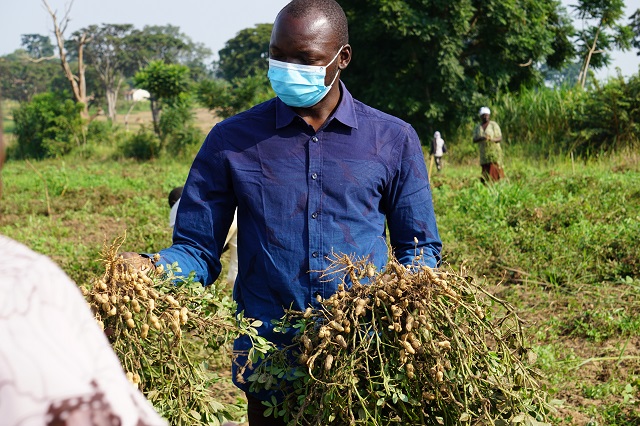
Since the 1920’s, Uganda’s research efforts have released 24 varieties, the recent commercial varieties being Serenut1-14 series
Kampala, Uganda | Isaac Khisa | Ann Apio has been growing groundnuts in Serere district, approximately 200km north east of Uganda’s capital Kampala for decades but has always had to content with difficulty in shelling pods as well as dealing with pests and diseases.
“The current groundnut pods are very hard to shell and this slows down the whole process. It also makes our hands to pain,” she told The Independent in an interview on Aug. 25 as she harvests a new groundnut variety still undergoing research at the National Semi-Arid Research Institute (NaSARRI).
“We now hope that this new variety will help solve this challenge, it is easy to shell, has a nice aroma and sweet.”
Scientists at the NaSARRI are improving various groundnut varieties to meet the end user needs including farmers, processors and consumers.
Dr. David Okello Kalule, a plant breeder and national groundnuts project leader in Uganda, said NaSARRI plans to release a number of improved groundnut varieties including the Serere Ground Nut Variety 990400 abbreviated as SGV 990400 subject to meeting the relevant crop regulations.
He said the new groundnut variety is as a result of crossing two varieties; Serenut1 and Serenut 2 which were released way back in 2002. The two varieties have low yields, difficult to shell and are susceptible to drought.
“So, as much as farmers were using them- Serenut1 and Serenut 2 – they were asking for a variety that is high yielding and easy to shell the pods,” he said, adding that the current yields for the new groundnut variety stands at 1,250 kgs per hectare at the research station.
Other varieties undergoing improvement include; the locally grown Red Beauty and Erudu to boost yields and resistance to pests and diseases.
Red Beauty, which was first released to farmers in 1966 and has been home saved ever since, has been improved to resist against rosette virus. The variety has also been made to mature in 85 days compared to 90 days. The seeds are deep attractive red in colour and are small in size.
“Red Beauty yields stand at approximately 2,500 kgs per hectare on station,” Dr. Kalule said. “Meaning that a farmer can at least get two thirds of this on his or her farm, while maintaining its old good attributes – good aroma, good for boiling and high oil content. So, here, we only added improved yields, resistant to rosette virus and tolerant to drought.”
Similarly, Erudu, a local variety for peanut butter production in the Teso sub-region has been improved to resist late leafspot and the rosette virus. The local Erudu groundnut variety was crossed with Serenut 3R to come up with the Erudu 100100.
“We hope these groundnut improvements will boost production and farmers’ incomes and livelihoods,” Dr. Kalule said.
Ground nut is the second most important legume after beans in Uganda, with an estimated cultivated area of nearly 260,000 hectare, representing 24.6% of the total arable land.
However, on farm, yields are low, averaging 800 kg per hectare of dry pods, compared to on-station yields of 3,000 per hectare. The yield gaps are attributed to a combination of biotic, abiotic, cultural and political factors.
Since the 1920’s, research efforts have released 24 varieties, the recent commercial varieties being Serenut1-14 series.
These varieties have helped to alleviate some of the production problems. However, varied growing agro-ecologies, land tenure systems, diverse market preferences and emerging stresses call for continued research.
The current research includes breeding for high oleic, leafminer resistance, confectionary, aflatoxin tolerance, and early to medium maturing varieties in high yielding groundnut rosette virus resistant background.
In performing these tasks, the scientists have initiated Marker Assisted Selection and adopted BMS for digitalization of data capture, management, analysis and storage.
To date, the groundnut breeding program has an attractive breeding pipeline releasing varieties and lines which have already been shared with national programmes across African countries including; South Sudan, Ethiopia, Ghana, Mozambique, Mali and Malawi as well as Haiti.
Storage
Meanwhile, Dr. Kalule said it is important to remove all damaged, discolored, rotted, immature and sprouted pods, other plant materials and soil from the produce before storage.
He said groundnut stores better in pods than in seeds adding that unfavorable conditions, groundnut seed losses viability so easily.
“Safe storage of groundnut requires an atmosphere with low relative humidity of 60 to 70%. Storage facilities for groundnuts should be weather proof and free from insect and disease bearing litre,” he said.
“Buildings should have provisions for good ventilation to prevent condensation of water. Store the dry pods in gunny bags and stark them up to 10 bags high in separated starks so that air freely circulates among them,” he said.
He said proper storage is important to maintain groundnut quality and prevent aflatoxin contamination saying they are potent to cancer causing chemicals.
“Thus, under no conditions should moldy groundnuts be eaten or sold,” he said.
Dr. Kalule, however, noted that although biotechnology can be used to address aflatoxin and other related challenges facing groundnut farmers, the current challenges can be solved using the available technologies.
He, however, said he welcomes any use of technology provided that it is home grown and meant to solve a home solution.
 The Independent Uganda: You get the Truth we Pay the Price
The Independent Uganda: You get the Truth we Pay the Price



